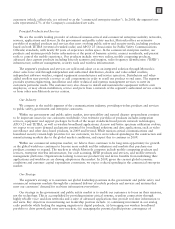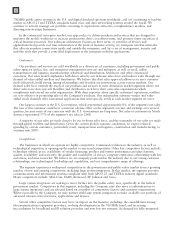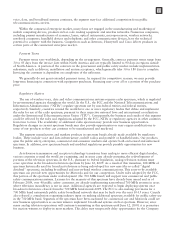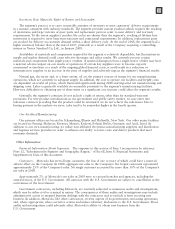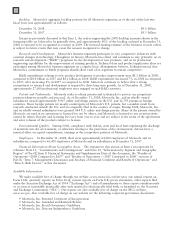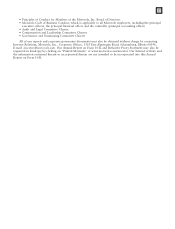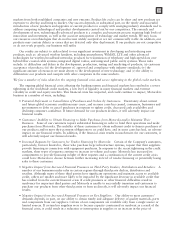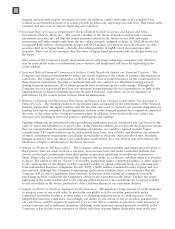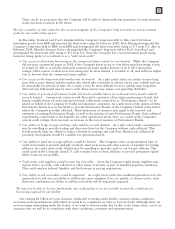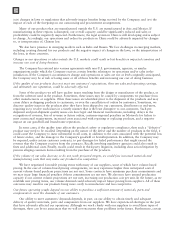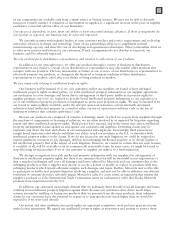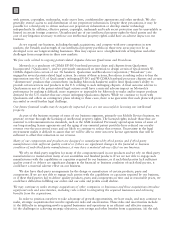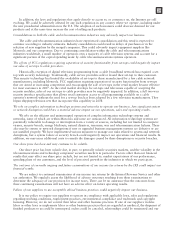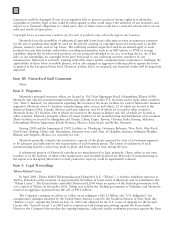Motorola 2008 Annual Report Download - page 29
Download and view the complete annual report
Please find page 29 of the 2008 Motorola annual report below. You can navigate through the pages in the report by either clicking on the pages listed below, or by using the keyword search tool below to find specific information within the annual report.
There can be no assurances that the Company will be able to obtain sufficient quantities of credit insurance
in the necessary locations in the future.
We face a number of risks related to the recent downgrade of the Company’s long-term debt to non-investment
grade by one credit rating agency:
In December, Standard and Poor’s downgraded the Company’s long-term debt to BB+ (one level below
investment grade) from BBB and removed the short-term rating. In February 2009, Fitch Ratings downgraded the
Company’s long-term debt to BBB- from BBB and downgraded the short-term debt rating to F-3 from F-2. Also in
February 2009, Moody’s Investor Service downgraded the Company’s long-term debt to Baa3 from Baa2 and
downgraded the short-term debt rating to P-3 from P-2. Since the Company has a non-investment grade rating
from one rating agency, it is referred to as a “split rated credit”.
•Our access to short-term borrowing in the commercial paper market is very limited: While the Company
did not issue commercial paper in 2008, if the Company needs access to very short-term borrowing, it may
no longer be able to access the unsecured commercial paper market because of its P-3/F-3 short-term
ratings. Other sources of short-term borrowing may be more limited, if available at all, and will have higher
cost to borrow than the commercial paper market.
•Our access to the long-term debt market may be limited: As a split rated credit, our ability to issue long-
term debt is more limited and the market into which split rated debt is offered can be very volatile and can
be unavailable for periods of time. As a result, it may be more difficult for us to quickly issue long-term
debt and any debt issued may be more costly. These factors may impact our operating flexibility.
• Our ability to provide performance bonds, bid bonds, standby letters of credit and surety bonds could be
severely limited: Commercial contracts with Motorola’s customers often require performance bonds, bid
bonds, standby letters of credit and surety bonds (collectively, referred to as “Performance Bonds”) to be
issued on behalf of the Company by banks and insurance companies. As a split rated credit, issuers of these
Performance Bonds may be less likely to provide Performance Bonds on the Company’s behalf in the future,
unless the Company provides collateral. These limitations on issuance may apply to the renewal and
extension of existing Performance Bonds, as well as the issuance of new Performance Bonds. Such collateral
requirements could result in less liquidity for other operational needs. Also, as a result of the Company’s
current credit ratings, there has been an increase in the cost of issuance of Performance Bonds.
•Our ability to hedge foreign exchange risk could be severely limited: As a split rated credit, counterparties
may be unwilling to provide trading and derivative lines for the Company without cash collateral. This
would severely limit our ability to reduce volatility in earnings and cash flow. Should cash collateral be
provided, less liquidity would be available for operational needs.
•Our ability to fund our foreign affiliates could be limited: The Company relies on uncommitted lines of
credit from banks to provide daylight overdraft, short-term loans and other sources of liquidity for foreign
affiliates. As a split rated credit, lenders may be unwilling to provide credit to our foreign affiliates. This
could result in the Company using U.S. cash to make loans to these affiliates or provide permanent equity
where loans are not possible.
•Trade terms with suppliers could become less favorable: Given the Company’s split rating, suppliers may
require letters of credit, cash collateral or other forms of security as part of standard payment conditions.
This could result in reduced liquidity and less leverage in pricing negotiations.
•Our ability to sell receivables could be impacted: As a split rated credit, the conditions placed on us by the
parties that we sell our receivables to will become more stringent. If we are unable, or choose not to, meet
these new conditions, our ability to sell the receivables will be negatively impacted.
We may not be able to borrow funds under our credit facility if we are not able to meet the conditions for
borrowing required by our facility.
Our existing $2 billion five-year domestic syndicated revolving credit facility contains various conditions,
covenants and representations with which we must be in compliance in order to borrow funds. Although there are
no borrowings outstanding under the facility, if we wish to borrow under this facility in the future, there can be no
assurance that we will be in compliance with these conditions, covenants and representations.
21


